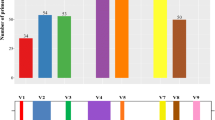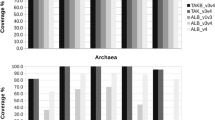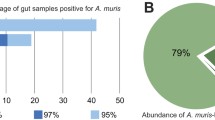Abstract
It remains an unsolved problem to quantify a natural microbial community by rapidly and conveniently measuring multiple species with functional significance. Most widely used high throughput next-generation sequencing methods can only generate information mainly for genus-level taxonomic identification and quantification, and detection of multiple species in a complex microbial community is still heavily dependent on approaches based on near full-length ribosome RNA gene or genome sequence information. In this study, we used near full-length rRNA gene library sequencing plus Primer-Blast to design species-specific primers based on whole microbial genome sequences. The primers were intended to be specific at the species level within relevant microbial communities, i.e., a defined genomics background. The primers were tested with samples collected from the Daqu (also called fermentation starters) and pit mud of a traditional Chinese liquor production plant. Sixteen pairs of primers were found to be suitable for identification of individual species. Among them, seven pairs were chosen to measure the abundance of microbial species through quantitative PCR. The combination of near full-length ribosome RNA gene library sequencing and Primer-Blast may represent a broadly useful protocol to quantify multiple species in complex microbial population samples with species-specific primers.




Similar content being viewed by others
References
Hong, X., Chen, J., Liu, L., Wu, H., et al. (2016). Metagenomic sequencing reveals the relationship between microbiota composition and quality of Chinese rice wine. Scientific Reports, 6, 26621.
Hess, M., et al. (2011). Metagenome discovery of biomass-degrading genes and genomes from cow rumen. Science, 331(6016), 463–467.
Blackwood, C. B., Oaks, A., & Buyer, J. S. (2005). Phylum-and class-specific PCR primers for general microbial community analysis. Applied and Environmental Microbiology, 71, 6193–6198.
Shin, S. G., Lee, C. S., Hwang, K., Ahn, J. H., & Hwang, S. (2008). Use of order-specific primers to investigate the methanogenic diversity in acetate enrichment system. Journal of Indian Microbiology and Biotechnology, 35, 1345–1352.
Gregoris, T. B. D., Aldred, N., Clare, A. S., & Burgess, J. G. (2011). Improvement of phylum- and class-specific primers for real-time PCR quantification of bacterial taxa. Journal of Microbiological Methods, 86, 351–356.
Hlousek, L., Voronov, S., Diankov, V., Leblang, A. B., et al. (2012). Automated high multiplex qPCR platform for simultaneous detection and quantification of multiple nucleic acid targets. BioTechniques, 52, 316–324.
Bui, M., & Liu, Z. (2009). Simple allele-discriminating PCR for cost-effective and rapid genotyping and mapping. Plant Methods, 5, 294–299.
Liong, M., Hoang, A. N., Chung, J., et al. (2013). Magnetic barcode assay for genetic detection of pathogens. Nature Communications, 4, 216–219.
Kyryl, Z., & Chan, W. C. W. (2013). A plasmonic DNAzyme strategy for point-of-care genetic detection of infectious pathogens. Angewandte Chemie International Edition, 52, 3168–3171.
Ye, J., Coulouris, G., Zaretskaya, I., Cutcutache, I., Rozen, S., & Madden, T. L. (2012). Primer-BLAST: A tool to design target-specific primers for polymerase chain reaction. BMC Bioinformatics, 13, 134.
Zheng, X. W., Tabrizi, M. R., Nout, M., & Han, B. Z. (2011). Daqu—A traditional Chinese liquor fermentation starter. Journal of the Institute of Brewing, 117, 82–90.
Zeng, J. B., Fan, S. G., Zhao, C. Y., et al. (2014). A colorimetric agarose gel for formaldehyde measurement based on nanotechnology involving Tollens reaction. Chemical Communications, 50, 8121–8123.
König, H., & Fröhlich, J. (2009). Lactic acid bacteria. Biology of microorganisms on grapes, in must and in wine (pp. 3–29). Heidelberg: Springer.
Leroy, F., & De Vuyst, L. (2004). Lactic acid bacteria as functional starter cultures for the food fermentation industry. Trends in Food Science & Technology, 15, 67–78.
Chang, J. Y., & Chang, H. C. (2010). Improvements in the quality and shelf life of kimchi by fermentation with the induced bacteriocin-producing strain, Leuconostoc citreum GJ7 as a starter. Journal of Food Science, 75, M103–M110.
Bao, Y., Zhang, Y., Zhang, Y., et al. (2010). Screening of potential probiotic properties of Lactobacillus fermentum isolated from traditional dairy products. Food Control, 21, 695–701.
Navarro, L., Zarazaga, M., Sáenz, J., Ruiz-Larrea, F., & Torres, C. (2000). Bacteriocin production by lactic acid bacteria isolated from Rioja red wines. Journal of Applied Microbiology, 88, 44–51.
Arbsuwan, N., Sirithorn, P., et al. (2014). Purification and characterization of antimicrobial substances from Bacillus licheniformis BFP011. Applied Biochemistry and Microbiology, 50, 580–587.
Sabu, A., Augur, C., Swati, C., & Pandey, A. (2006). Tannase production by Lactobacillus sp. ASR-S1 under solid-state fermentation. Process Biochemistry, 41, 575–580.
Belmares, R., Contreras-Esquivel, J. C., et al. (2004). Microbial production of tannase: An enzyme with potential use in food industry. LWT-Food Science and Technology, 37(8), 857–864.
Bi, C., Rice, J. D., & Preston, J. F. (2009). Complete fermentation of xylose and methylglucuronoxylose derived from methylglucuronoxylan by Enterobacter asburiae strain JDR-1. Applied and Environmental Microbiology, 75, 395–404.
Hedman, P., Ringertz, O., Eriksson, B., Kvarnfors, P., et al. (1990). Staphylococcus saprophyticus found to be a common contaminant of food. Journal of Infection, 21, 11–19.
Hu, X. L., Du, H., & Xu, Y. (2015). Identification and quantification of the caproic acid-producing bacterium Clostridium kluyveri in the fermentation of pit mud used for Chinese strong-aroma type liquor production. International Journal of Food Microbiology, 214, 116–122.
Acknowledgments
This study was supported by the NSFC (No. 31071170), GREDBIO fund, HIT (hitwh200904), and GujingGong fund (2016). The authors appreciate valuable help from graduate students Kaiqiang Li and Liyu Su for their technical assistance.
Author information
Authors and Affiliations
Corresponding authors
Electronic Supplementary Material
Below is the link to the electronic supplementary material.
Rights and permissions
About this article
Cite this article
Zhang, H., He, H., Yu, X. et al. Employment of Near Full-Length Ribosome Gene TA-Cloning and Primer-Blast to Detect Multiple Species in a Natural Complex Microbial Community Using Species-Specific Primers Designed with Their Genome Sequences. Mol Biotechnol 58, 729–737 (2016). https://doi.org/10.1007/s12033-016-9972-8
Published:
Issue Date:
DOI: https://doi.org/10.1007/s12033-016-9972-8




